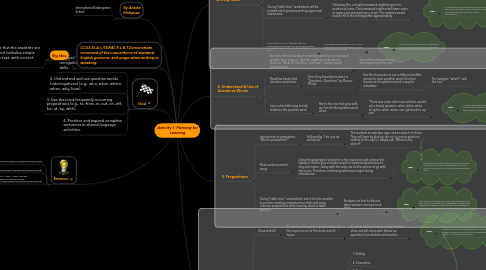
1. Goal
1.1. 1. Upper/ lowercase letter recognitions and organised writing skills.
1.2. 2. Understand and use question words (interrogatives) (e.g., who, what, where, when, why, how).
1.3. 3. Use the most frequently occurring prepositions (e.g., to, from, in, out, on, off, for, of, by, with).
1.4. 4. Produce and expand complete sentences in shared language activities.
2. References
2.1. Edutopia http://www.edutopia.org/blog/scaffolding-lessons-six-strategies-rebecca-alber
2.2. Growing Book by Book http://growingbookbybook.com/reading-comprehension-rainbow-retelling/
2.3. Larkin, M. (2002). Using scaffolded instruction to optimize learning. http://www.vtaide.com/png/ERIC/Scaffolding.htm
3. CCSS.ELA-LITERACY.L.K.1 Demonstrate command of the conventions of standard English grammar and usage when writing or speaking.
3.1. Big Idea
3.1.1. The goal is to ensure that the students are able to read, write and verbalise simple sentences in a given text, with correct grammar.
4. By Ankita Mohanan
4.1. International Kindergarten School
5. 1. Upper/ Lowercase & Writing Skills
5.1. Upper and lower cases will be demonstrated/shown on the white board.
5.2. Students will have a casual go at it during board time. They will come to the board and demonstrate what they learnt.
5.2.1. Why?
5.2.1.1. To make it fun and to let some positive reinforcements from friends and teachers
5.2.1.2. Allow some healthy/positive competitiveness, to encourage students to always try their best and work hard.
5.3. During "table time," worksheets will be handed out to practice writing upper and lowercases.
5.3.1. Following this, a simple homework might be given to practice at home. The homework might entail lower cases or upper case missing from a chart. The students would have to fill in the missing letter approximately.
5.3.1.1. Why?
5.3.1.1.1. So that the students who are shy/nervous in class and require that extra time to take it all in, get the opportunity to do so in a more relaxed enviornment.
5.4. Introduction to C.O.P.S. (Capitals, Organise, Punctuations and Spelling) This will be demonstrated on the white board and once again during "table time."
5.4.1. A laminated checklist sheet of C.O.P.S will be placed on each students table, to revise their writing on their own.
5.4.1.1. Why?
5.4.1.1.1. To offer hints and suggestions, leading them to the connections a bit, but once they get there, they will grasp it as their own.
6. 2. Understand & Use of Questions Words
6.1. Be really intentional about modeling curiosity and a sense of wonder from early on. Get the students constantly be thinking, "What if? and Why? and How?" during regualr conversations.
6.1.1. You set the standard from the beginning of the year.
6.2. Read few books that introduce questions.
6.2.1. One of my favorites to share is "Questions, Questions" by Marcus Pfister.
6.2.1.1. Use the characters or use a different stuffed animal for each question word. One that rhymes so the question word is easy to remember.
6.2.1.1.1. For example: "when?" said the hen!
6.3. Learn a fun little song to help reinforce the question word.
6.3.1. Here's the one that goes with our hen for the question word when:
6.3.1.1. "There was a hen, who now and then, would ask a timely question, when, when, when, oh, when, when, when, can I get back to my pen."
6.3.1.1.1. Why?
7. 3. Prepositions
7.1. Introduction to preposition, "What is preposition?"
7.1.1. Followed by "I do, you do and we do"
7.1.1.1. The students to take two cups and an object of choice. They will learn by placing the car in various positions relative to the cup/s, I simply ask, “Where is the object?”
7.2. Music and movement songs
7.2.1. Using the powerpoint projector in the classroom and connect the laptop or iPad to play a simple song that students would enjoy to sing and repeat. Along with the song, we do the actions to go with the music. Therefore, reinforcing what was taught during introduction.
7.2.1.1. Why?
7.2.1.1.1. Taking into consideration the types of students that are in class. From special needs(ADHD) to music lovers. It is an outlet that all levels of students would enjoy.
7.3. During "table time," a worksheet, which lets the student to practice reading comprehension skills and using common prepositions while learning about relative position.
7.3.1. Students are free to discuss ideas/answers amongst each other.
7.3.1.1. Why?
7.3.1.1.1. Peer teaching. Students learn more from each other than their teacher. Using that to my advantage, this allows shy students to become confident at their work and teaches them teamwork.
8. 4. Produce and Expand Language
8.1. Show and tell
8.1.1. Students will be given a weeks notice, of the requirements of the show and tell topics.
8.1.1.1. Students will take 5 mins, to explain their show and tell, along with follow-up questions from friends and teachers.
8.1.1.1.1. Why?
8.2. Story Retelling: This could be verbal or written.
8.2.1. Students are taught the "5 Finger Retell"
8.2.1.1. 1. Setting
8.2.1.2. 2. Characters
8.2.1.3. 3. Problems
8.2.1.4. 4. Events
8.2.1.5. 5. Solution
8.2.1.5.1. Through these students can write in journals or verbalise their thoughts, depending on the activity chosen.
8.3. Build reading comprehension skills with a fun rainbow retelling bracelet. A great way to teach kindergarteners and other young readers how to retell a story, while expanding their language through creativity. (See comment box for a video example)
8.3.1. This activity can be done with a story that a child has listened to or one that child has read on her own.
8.3.1.1. Why?
8.3.1.1.1. Nervous students generally rely on a physical objects or movements to keep them going. A simple bracelet acts as a veil/reminder that they are able to do the activity without forgetting what is required. In simple terms "a confidence booster."
